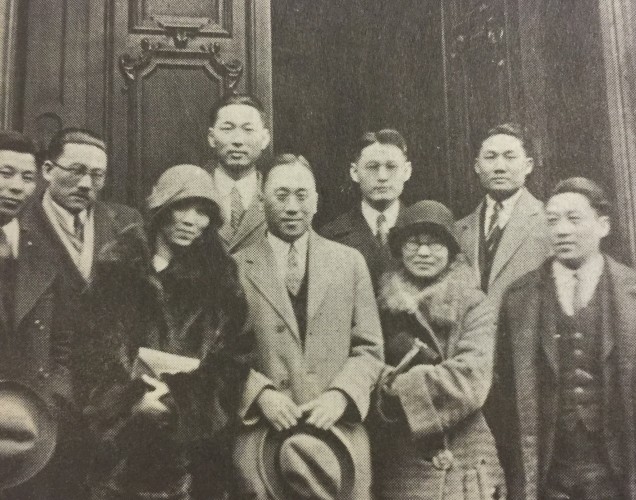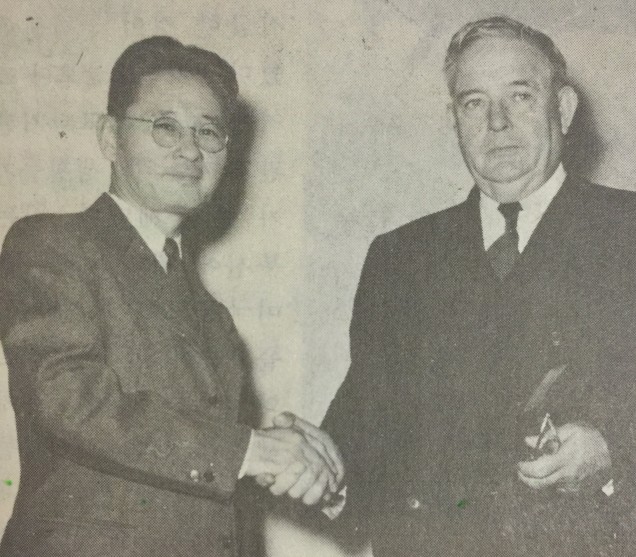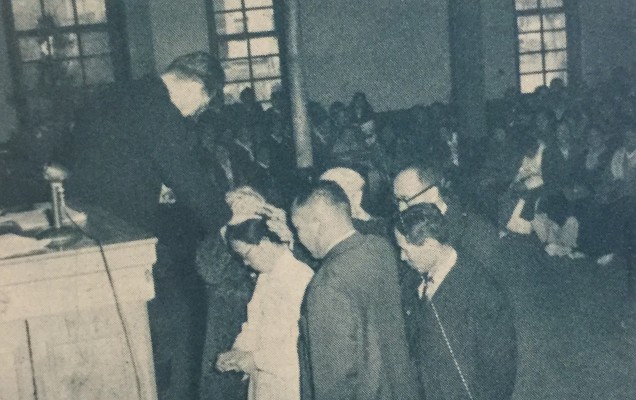Lew Hyungki, the Pillar of the Korean Methodist Church Reconstruction
After the Korean War in 1953, South Korea was in ruins. The land of Korea was destroyed and so were the churches and their work.[1] Despite the fact that the Methodist Church in Korea survived the Japanese occupation, it struggled after independence and the Korean War. Yet in the midst of those trying circumstances, Lew Hyungki made significant efforts to reconstruct and develop the Korean Methodist Church.

Lew was born in 1897 and fortunately he was offered the best as well as the highest level of education from his childhood onward. He was educated at Yeongbyeon Sungdeok School, Baejae School, and Sungsil School, which were founded by missionaries.[2] He then had an opportunity to study abroad at Cheongsan Academy in Tokyo, Japan, which is now Aoyama University. After his education in Japan, he moved to the United States to study through the help of the Methodist Episcopal Bishop Herbert Welch, who was a former president of Ohio Wesleyan University.[3] In the United States, he pursued a bachelor’s degree at Ohio Wesleyan University and, after a brief stint at Garrett-Evangelical Theological Seminary, he earned Master’s degrees from the Boston University School of Theology and Harvard University.[4] While he was staying in Chicago, Ohio, and Boston for his study, he associated with a lot of important Koreans at the schools that he attended and places where he lived, such as Jang Riuk, the former president of Seoul National University and an ambassador to the United States, and Kim Hwal-lan(Kim Helen), the former president of Ewha Womans University.[5] Their connection continued even after they went back to Korea.

He met his wife Sin Hyeongsuk (Julia) while she was studying at Dubuque University.[6] Shin, who was born in 1898 and graduated from Ewha Womans University in 1917 as the school’s fourth graduate, was distinguished as a Sin yeoseong (New Woman), a woman who was modernized through education and no longer defined by a woman’s traditional role.[7] With her close friend Kim Hwal-lan (Kim Helen), students from Ewha Womans University, and others, Shin even published the journal Sin yeoseong (New Woman) in 1929.[8] Furthermore, she was a prominent independence activist, known especially as one of the teachers of Yu Kwan-Sun, the most famous independence activist. In 1919, due to her serious engagement in the March 1st independence movement, she was imprisoned on a charge of inciting the movement.[9] It was true that she was in one of the groups that plotted the independence movement, so after her four months in prison, she moved to the United States, where she met Lew Hyungki.[10] She earned a bachelor’s degree at Ohio Wesleyan University and master’s degree at Boston University, majoring in social ethics.[11]
Lew Hyungki continued his studies in Boston. However, when he was studying in the Doctor of Philosophy program at Boston University, he was asked to come back to Korea by Bishop Welch to work for the Korean Methodist Church through its Department of Education. In order to fulfill Welch’s request, Lew quit his Ph.D. program and went back to Korea in 1927.[12]
From the time he arrived in Korea, Lew became deeply involved in the education system of the Korean Methodist Church. He first organized the publication of the journal Sinsaeng (New Life) in September 1928, which was a journal for young adults.[13] A later publication led to an historical moment for Korean Christianity. In 1934, he worked with forty other Korean scholars—both Methodist and Presbyterian—to translate The Abingdon Bible Commentary.[14] The translation was a landmark achievement as it was the very first commentary to be translated into Korean, and because it produced a major theological dispute among Presbyterians.[15] When the translated version of the commentary was introduced, it was not controversial among Korean Methodists, but it was for the Presbyterians. Most Presbyterians were opposed to the commentary as they thought it displayed a liberal interpretation, which threatened their belief in the inerrancy of the Bible.[16] Nonetheless, the book was not retracted, and therefore introduced liberal Biblical interpretation to Korean Presbyterians.[17] Inadvertently, the translation of The Abingdon Bible Commentary, which was published under the leadership of Lew Hyungki, escalated the controversy between Korean Methodists and Presbyterians as a successor to the disagreement over whether Shinto Shrine worship was idolatrous or not, and the division over hymnals in the early 20th century.[18]
In 1945, Lew became the administrator of the Joseon Printing Office, which was the second largest printing office in Seoul, and it helped him publish numerous books for the Korean Church. His contributions to publishing, however, did not only stay within the Church but extended to a broader arena. He produced a significant publication, Singsang (New Life) English-Korean Dictionary in 1946. It was a best seller at the time, and crucial in the history of Korea as it was the first English-Korean Dictionary to be translated by a Korean. There were a few English-Korean Dictionaries published by foreigners, such as the one produced by the missionary Horace Grant Underwood in 1890, but most Koreans relied on English-Japanese Dictionaries when studying and translating English until the Singsang New Life English-Korean Dictionary appeared.[19] The Dictionary was widely used in Korea. Lew and his dictionary marked a new era in the history of English education in Korea.

He did not cease to work for the Korean Methodist Church and his contributions continued through his position at Methodist Theological Seminary. He served the seminary from 1949 to 1953 as the principal. As it was only a few years after the liberation from Japanese occupation, the school needed to be renovated and it was done under the leadership of Lew.[20] However, his actual role as principal only lasted for two years, because he vacated the position in 1951 to become the Bishop of the Korean Methodist Church.
The kidnapping of the Bishop of the Korean Methodist Church, Kim Yuseon, by North Koreans vacated the bishop’s position in 1949. Therefore, in November 1951, Lew was elected as the Bishop of the Korean Methodist Church.[21] He held the position until 1958, and during those years his contributions to the Korean Methodist Church reached their summit. The most significant work done by him was the reconstruction of the Korean Methodist Church. More than a thousand Methodist churches were left damaged, including Jungdong First Methodist Church, by the Korean War. Under the leadership of Bishop Lew, the Korean Methodist Church attempted to recover its original shape.
However, to restore the Methodist Church, they needed help and money as they faced financial shortages. To solve the fiscal problem, Lew focused on fundraising for the reconstruction of the Korean Methodist Church while he was Bishop and even after his retirement. In order to collect contributions for the restoration of the Korean Methodist churches, he spent about half of his time as Bishop in the United States. As a result of his active fundraising work, people and churches in the United States sent a great deal of relief supplies and money to the Korean Methodist Church. With the active involvement of the American Methodist Bishops in the United States, the Church even raised 1.6 million dollars, which was a tremendous amount of money at that time, for the reconstruction of the Korean Methodist Church.[22]

Lew’s influence can also be found in the history of Korean women’s ordination. Until 1955, there were no Korean female ordained pastors within any denomination in Korea, even though the Korean Methodist Church decided in favor of women’s ordination in its discipline in 1931.[23] Lew officiated at Jeon Mil La’s ordination in 1955 at Jungdong First Methodist Church. Jeon, who graduated from Methodist Theological University in Korea in 1935, became the very first Korean woman ever to be an ordained pastor.[24] Lew led the Korean Methodist Church through this historical moment in Korean Christianity. After this incident, the Korean Methodist Church began to produce more female pastors, which was much earlier than other denominations in Korea. The Presbyterian Church in the Republic of Korea, for instance, only ordained a woman in 1974, and The Presbyterian Church of Korea waited until 1995.[25]
Lew Hyungki is one of the most important people in the Korean Methodist Church in the mid-20th century. He worked for the reconstruction of both Methodist Theological Seminary as the Principal, and the Methodist Church as the Bishop after the liberation from Japanese occupation, as well as during and after the Korean War. Lew wrote many books related to theology, including the translation of The Abingdon Bible Commentary. His contributions even widened to English education in Korea by publishing the very first English-Korean Dictionary written by Korean in Korea, Sinsang (New Life) English-Korean Dictionary, in 1946. Lew even played a part in ordaining the first Korean woman in the history of the Korean Church in 1955. Without a doubt, he was at the center of the Korean Methodist Church in its work of publication, and in its efforts to rebuild after the war.
[1] Mark A. Noll, The New Shape of World Christianity: How American Experience Reflects Global Faith (Downers Grove: IVP, 2009), 159.
[2] Hyungki J. Lew, Gamgyeok ui gusipnyeon: Ninety Years of Inspiration (Seoul: Korea Christian Cultural Institute, 1992), 13-17.
[3] Hyungki J. Lew, Eunchong ui palsiponyeon: Eighty-five Years of Amazing Grace, Memoirs of Bishop Hyungki Lew (Seoul: Korea Christian Cultural Institute, 1983), 51, 59, 60, and 64.
[5] Lew, Eunchong ui palsiponyeon: Eighty-five Years of Amazing Grace, Memoirs of Bishop Hyungki Lew, 73; and Lew, Gamgyeok ui gusipnyeon: Ninety Years of Inspiration, 26.
[6] Lew, Gamgyeok ui gusipnyeon: Ninety Years of Inspiration, 28.
[7] Lew, Eunchong ui palsiponyeon: Eighty-five Years of Amazing Grace, Memoirs of Bishop Hyungki Lew, 83; and Theodore Jun Yoo, The Politics of Gender in Colonial Korea: Education, Labor, and Health 1910-1945 (Los Angeles: University of California Press, 2008), 59.
[8] Yunsik Min, Sopa Bang jeonghwan pyeongjeon (The Biography of Jeonghwan Bang) (Seoul: Star Books, 2014), 193-194.
[9] The Compilation Committee of The Hundred Years of Ewha, Ewha baeknyeon, Volume 1 (The Hundred Years of Ewha) (Seoul: Ewha University, 1994), 129, 638 and Gyeongmin Im, “<3.1jeal teukjip> Ewhagyojeong neomeo ulryeo peojin ‘daehandokrip manse’ (<March 1st Special Report> Resonating ‘Hurrah for Korean independence’),” The Ewha Weekly, March 05, 2012, accessed March 01, 2015, http://inews.ewha.ac.kr/news/articleView.html?idxno=16862
[10] Seokchang Hong, Maebonggyohoe ga naheun minjok ui Bobae Yu Gwansun (Yu Gwansun, The Treasure who Maebong Church Produced), (Seoul: Sinang kwa Chisongsa, 2014), 75-76; and “Seoul eseoui yeoseong manse undong (Women’s Independence Movement in Seoul),” The History of Korean Independence Movement, accessed January 25, 2015, https://www.i815.or.kr/media_data/chong_new/e0004/e0004_15.htm
[11] The Compilation Committee of The Hundred Years of Ewha, Ewha baeknyeon (The Hundred years of Ewha), 149.
[12] Lew, Eunchong ui palsiponyeon: Eighty-five Years of Amazing Grace, Memoirs of Bishop Hyungki Lew, 81.
[13] Ije Jo, “Bishop Hyungki Lew,” The Presbyterian Church of Korea (PCK) World, June 07, 2003, accessed February 10, 2015, http://pckworld.com/news/articleView.html?idxno=2089
[14] Lew, Gamgyeok ui gusipnyeon: Ninety Years of Inspiration, 42.
[15] Dong-A Ilbo, “Seonggyeong juseok chulpan ginyeom (Commemoration of The Bible Commentary),” December 16, 1934, accessed Feburary 12, 2015 http://newslibrary.naver.com/viewer/index.nhn?articleId=1934121600209203006&editNo=2&printCount=1&publishDate=1934-12-16&officeId=00020&pageNo=3&printNo=5040&publishType=00020
[16] Sebastian C. H. Kim, ed., Christian Theology in Asia (Cambridge: Cambrdige University Press, 2008), 133; and Lew, Eunchong ui palsiponyeon: Eighty-five Years of Amazing Grace, Memoirs of Bishop Hyungki Lew, 103-104.
[17] Sangkyu Lee, “The Rise of Liberal Theology in the 1930s,” Kukmin Ilbo, January 29, 2012, accessed March 01, 2015, http://news.kmib.co.kr/article/view.asp?arcid=0005780375&code=23111612
[18] Chai-Shin Yu, ed., Korea and Christianity (Seoul: Korean Scholar Press, 1996), 99-100; Eduardus Van Der Borght, ed., Christian Identity (Leiden: Brill, 2008), 382; and Seokheung Park, “Chansongga ga tongil doenda (The Unity of Hymnals),” May 06, 1981, accessed March 20, 2015, http://newslibrary.naver.com/viewer/index.nhn?articleId=1981050600329211011&edtNo=2&printCount=1&publishDate=1981-05-06&officeId=00032&pageNo=11&printNo=10952&publishType=00020
[19] Jungho Choi, “ Haebanghu cheot Best Seller ‘Guinhoe’ (Guinhoe, the Best Seller After the Korean War),” Munhwa Ilbo, August 22, 1998, accessed February 22, http://www.munhwa.com/news/news_print.html?no=199808225000101; and Dong-A Ilbo, “Oegukeo sajeon pyeonchan (Compilation of foreign language dictionary),” April 11, 1979, accessed March 08, 2015, http://newslibrary.naver.com/viewer/index.nhn?articleId=1979041100209205008&edtNo=2&printCount=1&publishDate=1979-04-11&officeId=00020&pageNo=5&printNo=17694&publishType=00020
[20] Lew, Eunchong ui palsiponyeon: Eighty-five Years of Amazing Grace, Memoirs of Bishop Hyungki Lew, 151-152.
[21] Yusun Kim, “Encyclopedia of Korean Culture, ” accessed March 12, 2015, http://encykorea.aks.ac.kr/Contents/Index; Lew, Gamgyeok ui gusipnyeon: Ninety Years of Inspiration, 62; and Sangkyu Lee, “ Namhan eseo gyohoe jaegeon (Church Reconstruction in South Korea),” July 01, 2012, accessed March 09, 2015, http://news.kmib.co.kr/article/view.asp?arcid=0006203311&code=23111612
[22] Lew, Gamgyeok ui gusipnyeon: Ninety Years of Inspiration, 62-64.
[23] Hee An Choi, Korean Women and God: Experiencing God in a Multi-religious Colonial Context (Maryknoll, NY: Orbis Boosk, 2005), 121.
[24] Mil La Jeon, Tto dasi gidari neun maeum euro (Again, With a Heart of Waiting) (Seoul: Yanggang Church, 1986), 4, 10, 173; and Yugyeong Gang, “Jeon Mil La moksa neun yeoseong Moksaansu gil yeon gaecheokja (Rev. Mil La Jeon is the Pioneer who opened the way for women’s ordination),” The Christian Times, October 26, 2005, accessed January 26, 2015, http://www.kmctimes.com/news/articleView.html?idxno=18154
[25] Choi, Korean Women and God: Experiencing God in a Multi-religious Colonial Context, 121-122.
Written by: Younghwa Kim
Edited by: Daryl Ireland